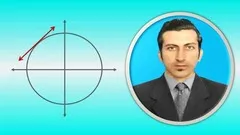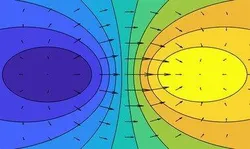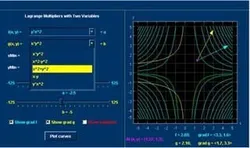
Calculus 3 (multivariable calculus) part 2 of 2 
In Calculus 3 (multivariable calculus) part 2 of 2, you will learn how to compute double and triple integrals, change variables in integrals, calculate line and surface integrals, and apply vector calculus theorems such as Greens, Gauss, and Stokes theorems. This course will equip you with the necessary skills to solve complex mathematical problems and apply calculus concepts in various real-world scenarios. Get a comprehesive understanding of this course which is a cost course. AZ Class provides this course data for free. Learn more certificate and details here. ▼
ADVERTISEMENT
Course Feature
![]() Cost:
Cost:
Paid
![]() Provider:
Provider:
Udemy
![]() Certificate:
Certificate:
Paid Certification
![]() Language:
Language:
English
![]() Start Date:
Start Date:
2023-06-05
Course Overview
❗The content presented here is sourced directly from Udemy platform. For comprehensive course details, including enrollment information, simply click on the 'Go to class' link on our website.
Updated in [October 18th, 2023]
What does this course tell? (Please note that the following overview content is from the original platform) Calculus 3 (multivariable calculus) part 2 of 2Towards and through the vector fields part 2 of 2: Integrals and vector calculus(Chapter numbers in Robert A Adams Christopher Essex: Calculus a complete course 8th or 9th edition)C4: Multiple integrals (Chapter 14)S1 Introduction to the courseS2 Repetition (Riemann integrals sets in the plane curves)S3 Double integralsYou will learn: compute double integrals on APR (axis-parallel rectangles) by iteration of single integrals; x-simple and y-simple domains; iteration of double integrals (Fubinis theorem)S4 Change of variables in double integralsYou will learn: compute double integrals via variable substitution (mainly to polar coordinates)S5 Improper integralsYou will learn: motivate if an improper integral is convergent or divergent; use the mean-value theorem for double integrals in order to compute the mean value for a two-variable function on a compact connected setS6 Triple integralsS7 Change of variables in triple integralsYou will learn: compute triple integrals by Fubinis theorem or by variable substitution to spherical or cylindrical coordinates; compute the Jacobian for various kinds of change of variablesS8 Applications of multiple integrals such as mass surface area mass centreYou will learn: apply multiple integrals for various aimsC5: Vector fields (Chapter15)S9 Vector fieldsS10 Conservative vector fieldsYou will learn: about vector fields in the plane and in the space; conservative vector fields; use the necessary condition for a vector field to be conservative; compute potential functions for conservative vector fieldsS11 Line integrals of functionsS12 Line integral of vector fieldsYou will learn: calculate both kinds of line integrals (the ones of functions and the ones of vector fields) and use them for computations of mass arc length work; three methods for computation of line integrals of vector fieldsS13 SurfacesYou will learn: understand surfaces described as graphs to two-variable functions f:R^2-R and as parametric surfaces being graphs of r:R^2-R^3; determine whether a surface is closed and determine surfaces boundary; determine normal vector to surfacesS14 Surface integralsYou will learn: calculate surface integrals of scalar functions and use them for computation of mass and areaS15 Oriented surfaces and flux integralsYou will learn: determine orientation of a surface; determine normal vector field; choose orientation of a surface which agrees with orientation of the surfaces boundary; calculate flux integrals and use them for computation of the flux of a vector field across a surfaceC6: Vector calculus (Chapter16: 161-165)S16 Gradient divergence and curl and some identities involving them; irrotational and solenoidal vector fields (Ch 161-2)S17 Greens theorem in the plane (Ch 163)S18 Gauss theorem (Divergence Theorem) in 3-space (Ch 164)S19 Stokes theorem (Ch 165)S20 Wrap-up Multivariable calculus & Calculus 3 part 2 of 2You will learn: define and compute curl and divergence of (two- and three-dimensional) vector fields and proof some basic formulas involving gradient divergence and curl; apply Greens Gausss and Stokess theorems estimate when it is possible (and convenient) to apply these theoremsMake sure that you check with your professor what parts of the course you will need for your final exam Such things vary from country to country from university to university and they can even vary from year to year at the same universityA detailed description of the content of the course with all the 200 videos and their titles and with the texts of all the 152 problems solved during this course is presented in the resource file "001 Outline_Calculus3_part2pdf" under video 1 ("Introduction to the course") This content is also presented in video 1 We considered the value of this course from many aspects, and finally summarized it for you from two aspects: skills and knowledge, and the people who benefit from it: (Please note that our content is optimized through artificial intelligence tools and carefully reviewed by our editorial staff.) What skills and knowledge will you acquire during this course? During this course, the learner will acquire the following skills and knowledge: 1. Compute double integrals on APR (axis-parallel rectangles) by iteration of single integrals. 2. Understand x-simple and y-simple domains and iterate double integrals using Fubini's theorem. 3. Compute double integrals via variable substitution, mainly to polar coordinates. 4. Determine if an improper integral is convergent or divergent and use the mean-value theorem for double integrals to compute the mean value for a two-variable function on a compact connected set. 5. Compute triple integrals using Fubini's theorem or variable substitution to spherical or cylindrical coordinates. 6. Compute the Jacobian for various kinds of change of variables in triple integrals. 7. Apply multiple integrals for various aims, such as mass, surface area, and mass center. 8. Understand vector fields in the plane and in space. 9. Identify conservative vector fields and use the necessary condition for a vector field to be conservative. 10. Calculate line integrals of functions and vector fields and use them for computations of mass, arc length, and work. 11. Understand surfaces described as graphs of two-variable functions and as parametric surfaces. 12. Determine whether a surface is closed and determine the surface's boundary. 13. Determine the normal vector to surfaces. 14. Calculate surface integrals of scalar functions and use them for computation of mass and area. 15. Determine the orientation of a surface and choose an orientation that agrees with the surface's boundary. 16. Calculate flux integrals and use them for computation of the flux of a vector field across a surface. 17. Define and compute curl and divergence of (two- and three-dimensional) vector fields and prove basic formulas involving gradient, divergence, and curl. 18. Apply Green's, Gauss's, and Stokes's theorems and estimate when it is possible and convenient to apply these theorems. It is important to consult with the professor to determine which parts of the course are necessary for the final exam, as this can vary depending on the country, university, and year. Who will benefit from this course? This course on Calculus 3 (multivariable calculus) will benefit students and professionals in various fields, including: 1. Mathematics and Physics Students: This course covers advanced topics in calculus, such as multiple integrals, vector fields, line integrals, surface integrals, and flux integrals. These concepts are essential for understanding and solving complex mathematical and physical problems. 2. Engineering Students: Calculus 3 is a fundamental course for engineering students, as it provides the necessary tools for analyzing and solving problems in fields such as fluid mechanics, electromagnetism, and structural analysis. The topics covered in this course, such as triple integrals and the divergence theorem, are particularly relevant to engineering applications. 3. Computer Science Students: Many computer science algorithms and techniques rely on concepts from multivariable calculus. Understanding vector fields, line integrals, and surface integrals can be beneficial for computer graphics, computer vision, and scientific computing. 4. Economics and Finance Students: Calculus 3 introduces students to optimization techniques and the concept of constrained optimization. These concepts are essential for understanding economic models and financial analysis. 5. Environmental Science and Geology Students: The concepts of flux integrals and the divergence theorem are particularly relevant to students studying environmental science and geology. These concepts are used to analyze the flow of fluids, such as groundwater, and to understand the behavior of vector fields in natural systems. 6. Architecture and Design Students: Calculus 3 provides tools for calculating surface area and volume, which are essential for architectural design and modeling. Understanding triple integrals and surface integrals can help architects and designers accurately calculate quantities such as material usage and structural stability. Overall, this course is beneficial for anyone seeking a deeper understanding of calculus and its applications in various fields.
Course Syllabus
Introduction to the course
Repetition (Riemann integrals, sets in the plane, curves)
Double integrals
Change of variables in double integrals
Improper integrals
Triple integrals
Change of variables in triple integrals
Applications of multiple integrals
Vector fields
Conservative vector fields
Line integrals of functions
Line integrals of vector fields
Surfaces
Surface integrals
Oriented surfaces and flux integrals
Gradient, divergence and curl
Green's theorem in the plane
Gauss' theorem (Divergence theorem) in 3-space
Stokes' theorem
Wrap-up Multivariable calculus / Calculus 3, part 2 of 2
Extras
Course Provider

Provider Udemy's Stats at AZClass
Discussion and Reviews
0.0 (Based on 0 reviews)
Explore Similar Online Courses

Become a Full Master of Calculus 1 - Learn step by step

Calculus

Python for Informatics: Exploring Information

Social Network Analysis

Introduction to Systematic Review and Meta-Analysis

The Analytics Edge

DCO042 - Python For Informatics

Causal Diagrams: Draw Your Assumptions Before Your Conclusions

Whole genome sequencing of bacterial genomes - tools and applications

Multivariable Calculus 1: Vectors and Derivatives

Multivariable Calculus (Fall 2007)


Start your review of Calculus 3 (multivariable calculus) part 2 of 2